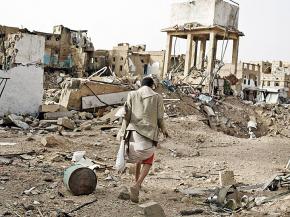How the U.S. aids and abets Saudi war crimes
Saudi Arabia’s devastating war on Yemen has been made possible by arms sales and political support from the U.S. and other governments, writes , in an article for the Australian socialist newspaper Red Flag.
THE SAUDI-led war on Yemen has devastated a country already crippled by widespread poverty and systematic neglect.
In 2015, Saudi Arabia and its allies launched what has become a vicious, unrelenting assault on a defenseless population. Their goal is to defeat the Houthi rebels, who have refused to back the puppet government installed by the Saudis in 2011.
Despite tens of thousands of air strikes and a debilitating air and naval blockade, they have failed to dislodge the rebels from the capital of Sanaa. Indeed, the Houthis now control large parts of the country.
Often cynically portrayed as Iranian puppets, the Houthis receive far less support than is generally assumed. And their movement is motivated less by love for the ayatollahs than by longstanding socio-economic grievances with successive Saudi-backed dictators, and their exclusion from a transitional government established after the 2011 revolution.

This inconvenient truth was ignored by the Saudi regime, which exaggerated the risk posed by a supposed Iranian proxy on its doorstep to justify a massive military intervention. As a result, Yemen now faces the largest humanitarian emergency on the planet.
Some 14 million people are at risk of starving to death, according to a World Food Programme report. It is the most severe famine anywhere in the world for more than 100 years. Sixteen million people lack access to clean water, and a staggering 22 million people — 75 percent of the population — rely on aid.
The United Nations estimates that more than 3 million Yemenis have fled their homes, desperately seeking safety and security. Many now live in makeshift refugee camps, their weathered tents the only signs of life in an otherwise inhospitable landscape.
To force the Houthi rebels to surrender, the Saudis have repeatedly attacked and closed the port of Hodeida, which handled 70 percent of food imports prior to the war. They have tried to bully NGOs to stop aid programs in rebel-controlled regions. When persuasion has failed, they’ve used violence. Hospitals run by Médecins Sans Frontières (Doctors Without Borders) have been bombed many times.
Save the Children, an international human rights organization, estimates that 50,000 children died from poverty-related causes last year. That’s 137 pairs of smiling eyes left vacant each day; a final, bitter familial embrace every 10 minutes.
The country’s social divisions — communal, cultural and religious — are becoming canyon-like with the geographical carve-up. The Houthis control the north and central regions, al-Qaeda in the Arabian Peninsula controls the southeast, and forces loyal to the United Arab Emirates control the area surrounding the strategically vital port of Aden — they are considering unilateral secession from the north.
IN TRUTH, “Yemen” no longer exists. Emaciated by decades of underinvestment, ruling class corruption and neoliberal attacks, the country has received a knockout blow from the Saudis and their allies.
This calamity is an indictment of the so-called global order. In particular, it is an indictment of the U.S. and British governments, which have expanded their military sales to the Saudis: an example of the barbaric bipartisanship often displayed on issues of imperial foreign policy by Democrats and Republicans and by social democrats and conservatives.
A bomb that killed 40 children on a school bus in August was almost certainly produced in Texas by Lockheed Martin. Not satisfied with facilitating indiscriminate murder in this way, the West has provided secondary support, including intelligence on possible targets, in-air refuelling for bombing campaigns and an endless stream of high-end military equipment.
A report by UN investigators found evidence of mass murder, torture and rape of civilians. Yet when confronted with the facts, U.S. Secretary of Defense Jim Mattis insisted that murdering thousands of unarmed Yemeni civilians was an act of self-defense by the Saudi and Emirati monarchies. Secretary of State Mike Pompeo was more honest in a congressional memo that justified the Saudi-led intervention in terms of curtailing Iranian influence.
The Australian government has been similarly complicit. Earlier this year, independent news site New Matilda reported that licenses for the sale of military equipment to the Saudis have recently quadrupled. Christopher Pyne, minister for defense industry from 2016 and now minister for defense, and other government ministers have engaged in high level talks regarding the expansion of the Royal Saudi Navy.
Further, it was revealed last year that Australian warships have been conducting joint exercises with the Saudis — i.e. with the navy that is blocking desperately needed aid to 22 million civilians. To top it all off, a former Australian Army major general, Mike Hindmarsh, has been leading the Emirates’ fighting forces. His reward is reportedly a $500,000 annual salary. One can only imagine the hysteria if the Iranians or the Palestinians were paying his wages. But in this case, he has received no criticism or censure from the government or the mainstream media in Australia.
Almost 30 million Yemenis are suffering a brutal military siege. It is well past time that the Australia ended its relationship with the despicable Saudi regime and ended its involvement with war crimes.
First published at Red Flag.


